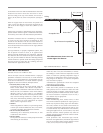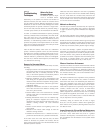
Wiring Supervision
The initiating circuits that con-
nect smoke detectors to a con-
trol panel should be super-
vised so that a fault (trouble) condition that could interfere
with the proper operation of the circuit will be detected
and annunciated.
Smoke detectors are generally categorized as either 2-wire
or 4-wire detectors. Two-wire detectors derive their power
directly from the same fire alarm control panel alarm initi-
ating device circuit over which they report an alarm.
Because of their dependency on the initiating circuit, 2-wire
detectors must be tested and listed for compatibility with
the control panel to be used, to ensure proper operation.
Four-wire detectors are powered from a separate pair of
wires, and, like the 2-wire detector, apply an electrical
short across the associated alarm initiating device circuit to
transmit an alarm (Figure 10). Because they do not derive
power from the alarm initiating device circuit, electrical
compatibility is predicated upon the operating parameters
of the power supply to which the detectors are connected
and not the initiating circuit. Supervision of the power to
4-wire detectors is mandated through the use of an end-of-
line power supervision relay. When power is on, the relay
contacts of the end-of-line relay are closed and connected
in series with the end-of-line resistor beyond the last initi-
ating device. Loss of power at any point in the power sup-
ply circuit will cause the relay to de-energize and a trouble
condition to occur on the initiating circuit.
NOTE*: Refer to the fire alarm control panel manufacturer’s
operating manual to determine the ability of a specific initi-
ating circuit to react in a “Class B” or “Class A” fashion.
For more information, see NFPA 72-1999, paragraphs A-2-
3.6.1.2, A-2-3.6.1.1, A-2-3.6.1.2(a), and A-2-3.6.1.2(b).
NFPA 72 requirements also dictate that alarm notification
appliances (including smoke detectors with built-in
sounders) produce the 3-pulse temporal pattern fire alarm
evacuation signal described in ANSI S3.41. (Audible
Emergency Evacuation Signals)
Situations Where Other Types of Detectors May Be Used
In certain circumstances where standard smoke detectors
are unsuitable, special-purpose detectors, such as flame
detectors, heat detectors, and other detection devices may
be used.
The application of these special types of detectors should
be based on an engineering survey and used in accordance
with the manufacturer’s installation instructions provided.
Smoke Detectors Have Limitations
Smoke detectors offer the earliest possible warning of fire.
They have saved thousands of lives in the past and will
SYSTEM SENSOR
5
save more in the future. Nevertheless, smoke detectors do
have limitations. They may not provide early warning of a
fire developing on another level of a building. A first floor
detector, for example, may not detect a second floor fire.
For this reason, detectors should be located on every level
of a building. In addition, detectors may not sense a fire
developing on the other side of a closed door. In areas
where doors are usually closed, detectors should be locat-
ed on both sides of the door.
As already indicated, detectors have sensing limitations.
Ionization detectors are better at detecting fast, flaming
fires than slow, smoldering fires. Photoelectric smoke
detectors sense smoldering fires better than flaming fires.
Because fires develop in different ways and are often
unpredictable in their growth, neither type of detector is
always best. A given detector may not always provide sig-
nificant advance warning of fires when fire protection prac-
tices are inadequate, nor when caused by violent explo-
sions, escaping gas, improper storage of flammable liquids
such as cleaning solvents, etc.
Section 3
Typical System
Layout
Class B Circuits
Class B circuits differentiate between short circuits across
the loop (alarm) and opens on the loop (trouble).
Supervision of this circuit is accomplished by passing a low
current through the installation wiring and an end-of-line
resistor. Increases or decreases in this supervisory current
are monitored by the fire alarm control panel and will
cause alarm or trouble conditions, respectively, to be indi-
cated. A single open in a Class B circuit disables all devices
electrically beyond the open.
*NFPA 72 now classifies initiating device circuits by “Style” and “Class”. Style B
is an example of a Class B circuit; Style D is an example of a Class A circuit.
INITIATING DEVICE
CIRCUIT
ZONE 1
TROUBLE ALARM
FIRE ALARM CONTROL UNIT
PRIMARY
POWER
SUPPLY
TYPICAL
INITIATING
DEVICES
END OF LINE
RESISTOR
Figure 10: Two-Wire Detector Circuit


















